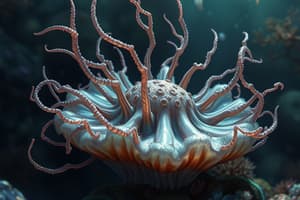Podcast
Questions and Answers
What is a characteristic of cnidarians' body structure?
What is a characteristic of cnidarians' body structure?
- Radial symmetry and no tissue layers
- Radial symmetry and three tissue layers
- Radial symmetry and two tissue layers (correct)
- Bilateral symmetry and two tissue layers
What is the main difference between polyps and medusae?
What is the main difference between polyps and medusae?
- Polyps are stationary, while medusae move freely (correct)
- Polyps are marine, while medusae are freshwater
- Polyps have a larger diameter, while medusae are smaller
- Polyps have multiple tentacles, while medusae have one
What is the location of the mouth in a polyp?
What is the location of the mouth in a polyp?
- On the top of the body (correct)
- At the bottom of the body
- On the side of the body
- On the inside of the body
What is the shape of a medusa's body?
What is the shape of a medusa's body?
What is the main function of the gastrovascular cavity?
What is the main function of the gastrovascular cavity?
What is a characteristic of the body cavity of cnidarians?
What is a characteristic of the body cavity of cnidarians?
What is the purpose of the cnidocytes in cnidarians?
What is the purpose of the cnidocytes in cnidarians?
Which of the following cnidarians exist only as polyps?
Which of the following cnidarians exist only as polyps?
What is the purpose of muscle cell contractions in some polyps?
What is the purpose of muscle cell contractions in some polyps?
What is unique about the cnidocytes of cubozoans?
What is unique about the cnidocytes of cubozoans?
What is a unique feature of some jellies?
What is a unique feature of some jellies?
What is the role of symbiotic algae in reef-building corals?
What is the role of symbiotic algae in reef-building corals?
Flashcards are hidden until you start studying
Study Notes
Characterization of Cnidarians
- Cnidarians are characterized by radial symmetry and bodies arising from only two tissue layers.
- Their simple body has an outer epidermis and an inner cell layer that lines the digestive cavity.
- A jelly-filled middle region may contain scattered amoeboid cells.
- Contractile tissues and nerves occur in their simplest forms in cnidarians.
Body Forms of Cnidarians
- There are two kinds of radially symmetric body forms: polyp and medusa.
- Polyps have a cylindrical body with tentacles projecting from one end, exemplified by hydras and sea anemones.
- Medusae are shaped like an umbrella with a fringe of tentacles around the lower edge, exemplified by marine jellies.
Life Cycle of Cnidarians
- Some cnidarians pass sequentially through both a polyp stage and a medusa stage in their life cycle.
- Others exist only as medusae; still others, including hydras and sea anemones, exist only as polyps.
Feeding and Digestion
- Cnidarians are carnivores that use their tentacles to capture small animals and protists and to push the prey into their mouths.
- The mouth leads into a multifunctional compartment called a gastrovascular cavity, where food is digested.
- Fluid in the gastrovascular cavity circulates nutrients and oxygen to internal cells and removes metabolic wastes.
Unique Features of Cnidarians
- Phylum Cnidaria is named for its unique stinging cells, called cnidocytes, that function in defense and in capturing prey.
- Each cnidocyte contains a fine thread coiled within a capsule that can sting or entangle prey when discharged.
- Some large marine cnidarians use their stinging threads to catch fish.
Coral Animals
- Coral animals are polyp-form cnidarians that secrete a hard external skeleton.
- Each generation builds on top of the skeletons of previous generations, constructing the characteristic shapes of coral reefs.
- Reef-building corals depend on sugars produced by symbiotic algae to supply them with enough energy to maintain the reef structure.
Studying That Suits You
Use AI to generate personalized quizzes and flashcards to suit your learning preferences.




